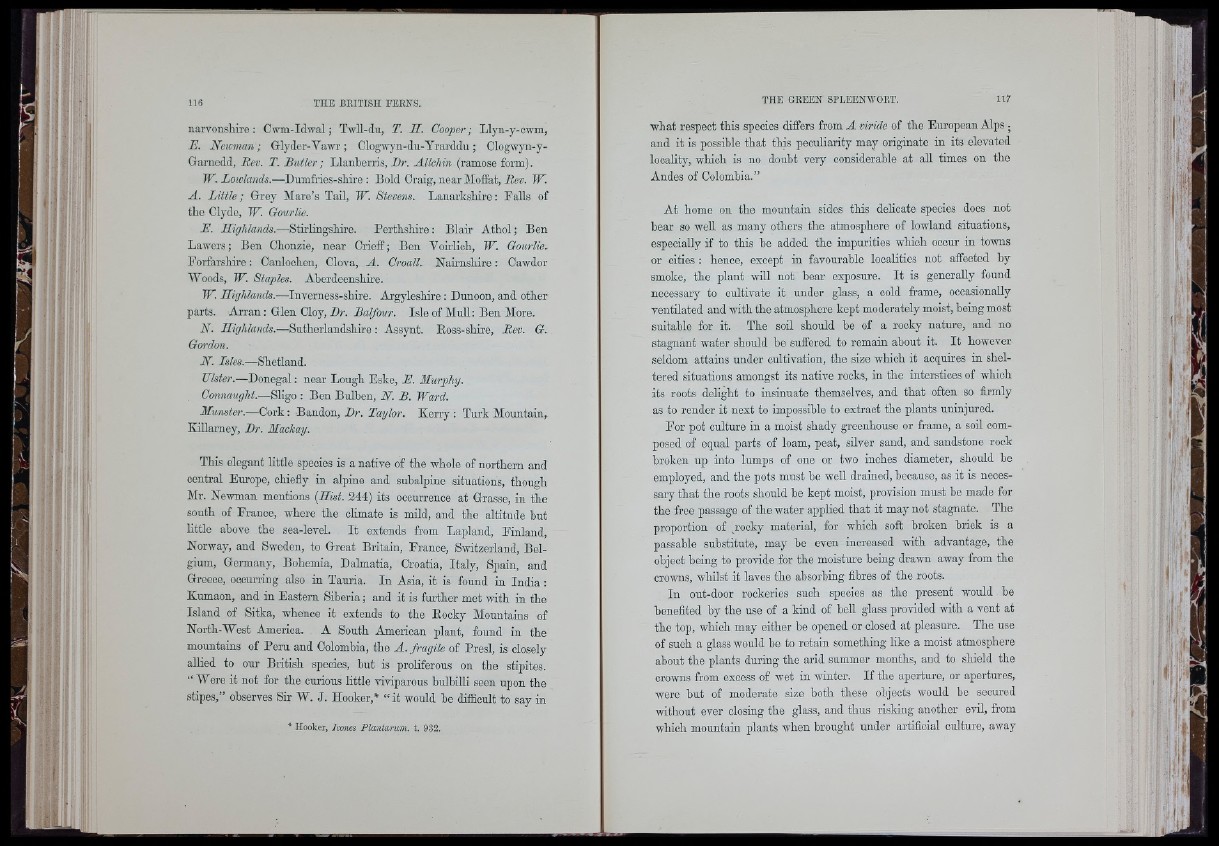
lb
■
i :
narvonshirc : Cwm-Idwal; Twll-du, T. IL Cooper; Llyn-y-owm,
E. Newman; Glydcr-Vawr; Clogwyn-du-Yrai-ddu; Clogwyn-y-
Gamcdd, Ltev. T. Butler; Llanberris, Br. Allchin (ramose form).
W. Lowlands.—Dumfries-sMre ; Bold Craig, near Jloffat, Rev. W.
A. L ittle ; Grey Mare’s Tail, W. Stevens. Lanarkshire: Falls of
tho Clyde, W. Goiirlie.
E. Highlands.—StirUngshire. Perthshire: Blair Athol; Ben
Lawers; Bon Chonzie, near Crieff; Ben Yoirlioh, W. Gotirlie.
Forfarshire: Canloohen, Clova, A. Croall. Nairnshire: Cawdor
Woods, W. Staples. Aberdeenshire.
W. Highlands.—Inverness-shire. Argyleshire: Dtmoon, and other
parts. Ai’ran: Glen Cloy, Dr. Balfour. Isle of Mull; Ben More.
N. Highlands.—Sutherlandshire : Assynt. Boss-shire, Rev. G.
Gordon.
N. Isles.—Shetland.
Ulster.—Donegal: near Lough Eske, E. Murphy.
Connaught.—Sligo : Ben Bulben, N. B. Ward.
Munster.—Cork; Bandon, Dr. Taylor. Kerry : Turk Mountain,
KiUarney, Dr. Mackay.
This elegant Uttle species is a native of the whole of northern and
central Europe, chiefly in alpine and subalpine situations, though
Mr. Newman mentions {Hist. 244) its occurrence at Grasse, in the
south of France, where the oUmate is mild, and the altitude but
Uttle above tUe sea-level. It extends from Lapland, Finland,
Norway, and Sweden, to Great Britain, France, Switzerland, Belgium,
Germany, Bohemia, Dalmatia, Croatia, Italy, Spain, and
Greece, occurring also in Tauria. In Asia, it is found in India :
Kumaon, and in Eastern Siberia; and it is further met with in the
Island of Sitka, whence it extends to the Rooky Mountains of
North-West America. A South American plant, found in the
mountains of Peru and Colombia, the A. fragile of Presl, is closely
allied to our British species, but is proliferous on the stipites.
“Were it not for the curious little viviparous bulbiUi seen upon the
stipes,” observes Sir W. J. Hooker,* “ it would be difficult to say in
* Hooker, Tmies Plantax'um. t. 932,
what respect this species differs from A viride of the European Alps ;
and it is possible that this peculiarity may originate in its elevated
locality, which is no doubt very considerable at aU times on the
Andes of Colombia.”
At home on the mountain sides this deUcate species does not
hear so well as many others the atmosphere of lowland situations,
especially if to this be added the impurities which occur in towns
or cities : hence, except in favourable localities not affected by
smoke, the plant will not bear exposure. It is generally found
necessary to cultivate it under glass, a cold frame, occasionally
ventilated and with the atmosphere kept moderately moist, being most
suitable for it. The soil should be of a rooky nature, and no
stagnant water should be suffered to remain about it. It however
seldom attains under cultivation, the size which it acquires in sheltered
situations amongst its native rocks, in the interstioes of which
its roots delight to insinuate themselves, and that often so firmly
as to render it next to impossible to extract the plants uninjured.
For pot culture in a moist shady greenhouse or frame, a soil composed
of equal parts of loam, peat, silver sand, and sandstone rook
broken up into lumps of one or two inches diameter, should he
employed, and the pots must he well drained, because, as it is necessary
that the roots should be kept moist, provision must bo made for
the free passage of the water apphed that it may not stagnate. The
proportion of rooky material, for which soft broken brick is a
passable substitute, may be even increased with advantage, the
object being to provide for the moisture being drawn away from the
crowns, whilst it laves the absorbing fibres of the roots.
In out-door rookeries such species as the present would be
benefited by the use of a kind of bell glass provided with a vent at
the top, which may either he opened or closed at pleasm'e. The use
of such a glass would be to retain something like a moist atmosphere
about the plants during the arid summer months, and to shield the
crowns from excess of wet in winter. If the aperture, or apertures,
were but of moderate size both these objects would be secured
without ever closing the glass, and thus risking another evil, from
which mountain plants when brought under artificial culture, away
' 'i t ■
' iji ii■
‘ ::.'i
•f ii. i I
I f G' I f
- H:
ijll
" i ' r i
'• II
-I»] i